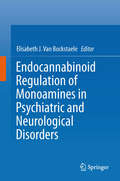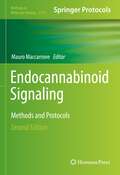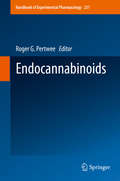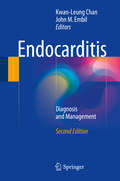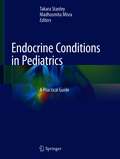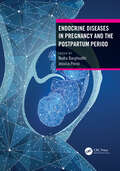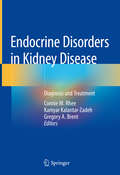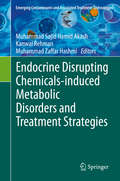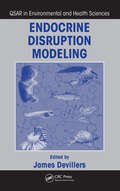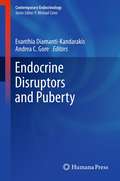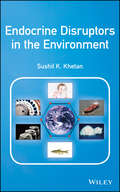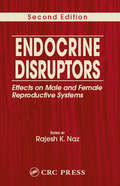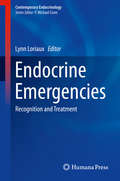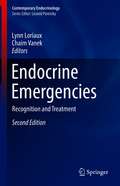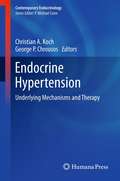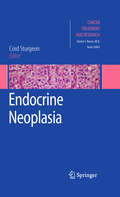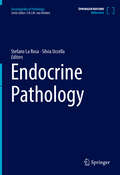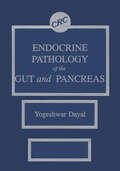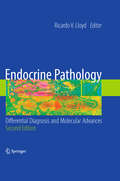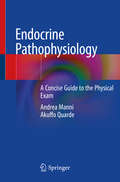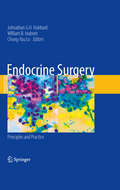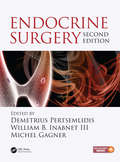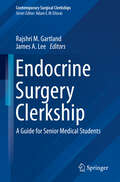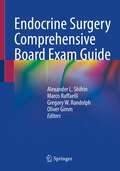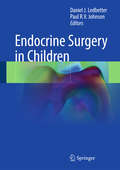- Table View
- List View
Endocannabinoid Regulation of Monoamines in Psychiatric and Neurological Disorders
by Elisabeth J. Van BockstaeleThe past decade has seen tremendous growth in the study of cannabinoid receptor signaling in brain. The impact and consequences of cannabinoid modulation of monoaminergic (dopamine, norepinephrine, and serotonin) circuits is becoming more clear. Scientists have shown significant interaction between these two systems in a variety of psychiatric and neurological disorders such as affective disorders, multiple sclerosis, and pain or pain disorders. The overarching goal of Endocannabinoid Regulation of Monoamines in Psychiatric and Neurological Disorders is to provide current information on advances in the field of endocannabinoid signaling and potential therapeutic applications with a particular emphasis on monoaminergic circuits.
Endocannabinoid Signaling: Methods and Protocols (Methods in Molecular Biology #2576)
by Mauro MaccarroneThis second edition provides new and updated chapters detailing all major elements of the ECB system. Chapters guide readers through identification of drug targets, electrophysiology, computational chemistry, and machine learning. Written in the successful Methods in Molecular Biology series format, chapters include introductions to their respective topics, lists of the necessary materials and reagents, step-by-step, readily reproducible protocols, and notes on troubleshooting and avoiding known pitfalls. Comprehensive and cutting-edge, Endocannabinoid Signaling: Methods and Protocols, Second Edition is a valuable resource for all researchers interested in learning more about this important and developing field.
Endocannabinoids
by Roger G. PertweeThere is currently considerable interest in the development of medicines that would enhance endocannabinoid-induced "autoprotection", for example through inhibition of endocannabinoid metabolizing enzymes or cellular uptake processes or that would oppose endocannabinoid-induced "autoimpairment". This volume describes the physiology, pathophysiology and pharmacology of the endocannabinoid system and potential strategies for targeting this system in the clinic.
Endocarditis
by Kwan-Leung Chan John M. EmbilThis new addition will provide an update on the current prophylaxis guidelines, the new diagnostic approach in the detection of the disease, the proposed schemas to predict prognosis, and the new treatment strategies to improve the outcome of patients afflicted with this serious condition. Endocarditis is a serious disease with ahigh rate of morbidity and mortality. The in-hospital mortality remains at 10-20%. The poor outcome ofpatients with this condition is due in large part to the delay in making thediagnosis which frequently can be elusive. As a result of its wide spectrum of manifestations, endocarditis canmimic many different conditions ranging from stroke to renal failure. In order to minimize the delay in diagnosis,clinicians need to always be mindful of the possibility that endocarditis maybe the cause of the symptoms. There have been ongoing efforts in thedevelopment of molecular probes and new imaging techniques to improve ourability to identify the disease early and reliably. New treatment strategies have been studiedwith the aim to prevent complications and to improve survival. Thestructure of the previous edition is preserved. The book is divided into three sections with the first section coveringthe historical perspective and basic principles, the second section dealingwith the diagnosis and management approaches and the last section on specificclinical situations that pose management dilemmas. All the chapters will be updated to include newinformation from the recent studies. Inparticular, the approach to the use of antibiotic prophylaxis will beextensively revised to present and discuss the implications of the currentguidelines from different national societies including the American HeartAssociation and the British Society for Antimicrobial Chemotherapy. This update is timely and should be ofinterest to all clinicians involved in the care of patients with this seriousdisease. This new edition will be a good resource forinternists, infectious disease specialists, cardiologists and cardiac surgeonsalike .
Endocrine Conditions in Pediatrics: A Practical Guide
by Madhusmita Misra Takara StanleyThis book is aimed at primary care providers who care for the pediatric age group (general pediatrician, the PCP working with pediatric patients, and family medicine providers) with the goal of covering the endocrine differential diagnosis of common signs and symptoms of possible endocrine disease as well as appropriate initial laboratory evaluation and interpretation. While multiple pediatric endocrine textbooks exist, most of them are heavy in coverage of physiology and rare diseases, with less discussion of practical steps in evaluation and diagnosis. This book distinguishes itself through a very practical approach. The first section is organized by presenting signs and symptoms, the second section is organized by laboratory interpretation, and the third section provides summaries of common pediatric endocrine disorders. Chapters are concise, providing critical clinical information including clinical pearls, common diagnoses and important points in patient counseling. Written by experts in the field, Endocrine Conditions in Pediatrics is a valuable resource that provides general pediatricians and other primary care providers with all of the information they need to provide superb patient care before transferring to a pediatric endocrinologist when necessary.
Endocrine Diseases in Pregnancy and the Postpartum Period
by Nadia BarghouthiThis book delivers comprehensive explanations of normal hormonal physiology during pregnancy and descriptions of the hormonal pathology associated with various endocrine disease states. In addition, it serves as a relevant and synoptic resource for the clinical management of endocrine disorders in pregnancy and the prepartum and postpartum periods. Evaluation and management of endocrine disorders including, but not limited to, diabetes mellitus, thyroid disease, and various endocrine tumors are discussed. It provides readers with a detailed overview in a compact and easy-to-read format. This book serves as essential reading for Endocrinology fellows and Obstetrics and Gynecology residents. KEY FEATURES Explains normal physiology of pregnancy in addition to the physiology, evaluation, and management of endocrine diseases in pregnancy and in the prepartum and postpartum periods Explores from a clinical standpoint with practical applications; useful for students, residents, fellows, mid-level providers, and practicing physicians Discusses special considerations and emerging topics including pregnancy in transgender men, obesity and metabolism, and endocrine emergencies
Endocrine Disorders in Kidney Disease: Diagnosis and Treatment
by Gregory A. Brent Kamyar Kalantar-Zadeh Connie M. RheeThis comprehensive book examines the complex interplay between endocrine and kidney disorders, and how this inter-relationship impacts patients with chronic kidney disease. Authored by experts in areas of endocrinology and nephrology, chapters cover a variety of topics, including diabetes, metabolic syndrome, thyroid dysfunction, gonadal disorders, dyslipidemia, mineral bone disorders, obesity, and pituitary disorders. These comorbidities are thoroughly examined and provide the clinician, researcher, and trainee with a greater understanding of the impact of endocrine disorders on kidney disease patients, the ability to identify persistent gaps in knowledge for future investigation, and move closer towards the goal of improving the health and survival of the chronic kidney disease population.
Endocrine Disrupting Chemicals-induced Metabolic Disorders and Treatment Strategies (Emerging Contaminants and Associated Treatment Technologies)
by Muhammad Zaffar Hashmi Muhammad Sajid Hamid Akash Kanwal RehmanThis volume offers a detailed and comprehensive analysis of Endocrine Disrupting Chemicals (EDCs), covering their occurrence, exposure to humans and the mechanisms that lead to the parthogenesis of EDCs-induced metabolic disorders. The book is divided into three parts. Part I describes the physiology of the human endocrine system, with special emphasis on various types of metabolic disorders along with risk factors that are responsible for the development of these disorders. Part II addresses all aspects of EDCs, including their role in the induction of various risk factors that are responsible for the development of metabolic disorders. Part III covers up-to-date environmental regulatory considerations and treatment strategies that have been adopted to cure and prevent EDCs-induced metabolic disorders. This section will primarily appeal to clinicians investigating the causes and treatment of metabolic disorders. The text will also be of interest to students and researchers in the fields of Environmental Pharmacology and Toxicology, Environmental Pollution, Pharmaceutical Biochemistry, Biotechnology, and Drug Metabolism/Pharmacokinetics.
Endocrine Disruption Modeling (QSAR in Environmental and Health Sciences)
by James DevillersUses Computational Tools to Simulate Endocrine Disruption PhenomenaEndocrine Disruption Modeling provides a practical overview of the current approaches for modeling endocrine activity and the related potential adverse effects they may induce on environmental and human health. Based on the extensive research of an international panel of contributor
Endocrine Disruptors and Puberty
by Evanthia Diamanti-Kandarakis Andrea C. GoreEndocrine disruption represents one of the most controversial environmental issues of our time. Mounting evidence stemming from more than 10 years of experimental, epidemiological and clinical studies has transformed the once generally discounted subject of endocrine disruptors into an issue of tremendous concern not only within the scientific community but among society as a whole. Following initial evidence from basic research, endocrine disruption in humans has now emerged as a major medical challenge. In this respect, puberty, a crucial developmental stage, has been definitively identified as a key window of vulnerability with regard to endocrine disruptors. Written by leading authorities in the field, Endocrine Disruptors and Puberty offers an engaging and comprehensive overview of this fascinating and rapidly growing problem. An indispensable resource for all clinicians and scientists interested in this challenging endocrinologic topic, Endocrine Disruptors and Puberty is a timely contribution that will help navigate a path toward understanding the problem and developing solutions.
Endocrine Disruptors in the Environment
by Sushil K. KhetanThe book is divided in three parts and 14 chapters. An introductory chapter provides an overview of endocrine system, and endocrine disruptors, discussing their salient features and presenting a historical perspective of endocrine disruption phenomena. The first part includes seven chapters that cover hormone-signalling mechanisms, followed by various broad classes of putative endocrine disruptors and an introduction to environmental epigenetic modifications. The second part in two chapters focuses on removal processes of various EDCs by biotic and abiotic transformation/ degradation. The third and final part consists of four chapters, embracing themes on finding solutions to environmental EDCs including their detection, regulation, replacement and remediation.
Endocrine Disruptors: Effects on Male and Female Reproductive Systems, Second Edition
by Rajesh K. NazThere is great concern regarding the reproductive and health hazards of endocrine disruptors. Research indicates that men are experiencing declining fertility and an increased incidence of prostate cancer, while women are dealing with increased infertility, early menopause, and breast cancer. As new research reveals the previously unknown risks of
Endocrine Emergencies
by Lynn LoriauxEndocrine Emergencies: Recognition and Treatment offers a state-of-the-art update on the management of endocrine, diabetic, and metabolic emergencies. Developed by renowned experts, this comprehensive and easy to read title brings the field fully up to date, setting a high standard for diagnosis and treatment in each category. All chapters begin with a summary that presents, in concentrated form, what the physician needs to know to begin the evaluation and emergency treatment of the known endocrine emergencies. This is followed by an extended discussion of the pathophysiology that can be read after initial treatment has begun. Covering such areas as hypoglycemia, acute adrenal insufficiency, ovarian hyperstimulation syndrome, thyroid storm, and pituitary apoplexy, just to name several, Endocrine Emergencies: Recognition and Treatment is an invaluable, practical resource that will be of great interest to endocrinologists, internal medicine and emergency room physicians, fellows and residents.
Endocrine Emergencies: Recognition and Treatment (Contemporary Endocrinology #74)
by Lynn Loriaux Chaim VanekMedical emergencies due to disorders of the endocrine system represent a unique category of clinical care. Hypotension, fever, palpitations, confusion, and electrolyte abnormalities are all signs of disparate endocrine emergencies that require immediate diagnoses and treatment. Recognition of endocrine emergencies will frequently lead to rapid improvement and stabilization of the patient.Now in a revised and expanded second edition including the latest clinical guidelines and protocols, Endocrine Emergencies serves as a handy single reference for any endocrinologist, internist, hospitalist, and emergency medicine physician to rapidly identify and initiate treatment. Topics covered include acute adrenal insufficiency, diabetic ketoacidosis, thyroid storm, hyponatremia, and myxedema coma, among many others. Each chapter opens with a precis that provides, in a single page, a presentation of symptoms, workup, and therapy. This serves as a rapid, “off the shelf” cue to immediately begin a differential diagnoses and therapy plan. The remainder of each chapter is an in-depth review of the pathophysiology, diagnoses, and management of the disease process. Book chapters are written by experts in the field and reflect the consensus and standard of care for specific endocrine emergencies.Updated with the latest clinical evidence and treatment options, Endocrine Emergencies remains a valuable resource for practitioners in endocrinology and internal medicine, as well as emergency room physicians, hospital support staff, fellows and residents.
Endocrine Hypertension
by Christian A Koch George P ChrousosThe prevalence of hypertension is almost three times as high as that of diabetes mellitus type 2, with both conditions being major risk factors for stroke, ischemic heart disease, cardiac arrhythmias, and heart failure. The exact prevalence of hypertension related to hormonal derangements (endocrine hypertension) is not known but estimated to affect less than 15% of hypertensive patients. Recent scientific discoveries have increased the understanding of the pathophysiologic mechanisms of hypertension. In Endocrine Hypertension, a renowned panel of experts provides a comprehensive, state-of-the-art overview of this disorder, discussing when to assign an endocrine cause in one of many conditions that may present with hypertension. The first part of Endocrine Hypertension is dedicated to adrenal causes. The second part of the volume concerns potential nonadrenal causes of hypertension, such as growth hormone excess or deficiency, primary hyperparathyroidism, vitamin D deficiency, testosterone deficiency, insulin resistance, obesity-associated hypertension, and the role of central mineralocorticoid receptors and cardiovascular disease. An important contribution to the literature, Endocrine Hypertension is an indispensable reference not only for endocrinologists, diabetologists, and adrenal investigators, but also for translational scientists and clinicians from cardiology, internal medicine, pediatrics, family medicine, geriatrics, urology, and reproductive medicine / gynecology.
Endocrine Neoplasia
by Cord SturgeonEndocrine Neoplasia is a comprehensive, updated, and clearly-written text covering the diseases for which endocrine surgical expertise is often needed. We look towards advances in the science and the art of endocrine surgery to continuously improve outcomes for our patients. The goal of this text was to provide a detailed description of both the underlying science of disease as well as the art of clinical management. The book is divided into five sections addressing neoplasms of the thyroid, parathyroid, adrenal gland, neuroendocrine pancreas, and multiple endocrine neoplasia. Experts from the United States, Canada, and Australia have contributed chapters addressing both the biology of endocrine tumors and the clinical management of disease. Recent discoveries regarding the genetic underpinnings of disease are highlighted. Updated consensus guidelines were used for clinical recommendations. The management of complex and often confusing clinical problems is discussed in detail.
Endocrine Pathology (Encyclopedia of Pathology)
by Stefano La Rosa Silvia UccellaThis encyclopedia volume covers the complete field of endocrine pathology – from Acidophil Stem Cell Adenoma to Waterhouse-Friderichsen syndrome. The alphabetically arranged entries, each of which provides a detailed description of a specific pathological disease pattern, allow readers to quickly and easily find the information they need.
Endocrine Pathology of the Gut and Pancreas
by Yogeshwar DayalThis important new book presents critical information on the clinical and morphological aspects of various endocrinological disorders of the gut and pancreas. Topics include a historical perspective and broad overview of the neuroendocrine component of the gut; hyperplastic proliferations of gastrointestinal endocrine cells; pancreatic endocrine cells and their non-neoplastic proliferations; tumors and lesions; and endocrine differentiation in nonendocrine tumors. The book stresses clinical and pathological aspects of these topics, as well as the pathogenesis, clinicopathological correlations, and diagnostic approaches. Gastroenterologists, pathologists, internists, surgeons, endocrinologists and others interested in endocrinological disorders of the gut and pancreas will discover that this book will be a welcome addition to your reference library.
Endocrine Pathology:
by Ricardo V. LloydEndocrine Pathology: Differential Diagnosis and Molecular Advances, Second Edition provides detailed coverage of endocrine pathology with extensive discussion of the differential diagnosis as well as presentation of molecular pathobiology of the major endocrine organs. Revised and expanded from the first edition, each chapter, written by leaders in their respective field, has been updated with the latest advances that are transforming the field of endocrine pathology. Richly illustrated with color photomicrographs, useful diagrams and line drawings, each chapter includes differential diagnosis of common and uncommon lesions as well as material on molecular developments, with emphasis on the molecular findings that are most helpful in the diagnosis of specific disorders. Endocrine Pathology: Differential Diagnosis and Molecular Advances, Second Edition, provides a useful and well-organized resource designed not only for the endocrine pathologist and the general surgical pathologist, but also for the clinical endocrinologist and the endocrine surgeon.
Endocrine Pathophysiology: A Concise Guide to the Physical Exam
by Andrea Manni Akuffo QuardeThis practical guide presents a concise approach to exploring endocrine pathophysiology through the physical exam, emphasizing common clinical signs in endocrinology that can be elicited through inspection, palpation, percussion or auscultation. The established and proposed mechanisms underlying these physical signs are highlighted, allowing students, residents and trainees to better appreciate endocrine pathophysiology at the bedside. The text is organized sensibly to facilitate quick and efficient review by medical trainees. Major diseases in endocrinology are grouped by organ systems - pituitary, thyroid, adrenal, and so on. Specific physical examination findings in each primary endocrine disease are reviewed and grouped under the categories of clinical features and pathophysiology, followed by related clinical and pathophysiology pearls. A brief description of the clinical finding is followed by a summary of the pathophysiologic mechanisms underlying the stated clinical finding. Relevant normal physiology and pathophysiology are reviewed where applicable, to facilitate learning. There are numerous texts on the pathophysiologic basis of diagnostic and laboratory findings in endocrinology. There is, however, no dedicated text to address questions that might be asked by trainees. Endocrine Pathophysiology satisfies this need in the literature.
Endocrine Surgery
by Chung-Yau Lo William B. Inabnet Johnathan HubbardThere has been a recent surge of interest within the world of endocrine surgery in the US and worldwide with resultant significant changes on the way surgery is performed. Where before a 5-7 year period was taken for a general surgeon, after which the medic would take a 1 year residency then a fellowship, now they are looking at 3 years core surgery and then going straight to specialise, opening up the discipline to more people. The book is a valuable tool for those revising for board examinations and Fellowship examinations. The text, compiled by expert authors from the USA, Europe and Asia, provides an international perspective on the basic knowledge and clinical management.
Endocrine Surgery
by William B. Inabnet III Demetrius Pertsemlidis Michel GagnerThe second edition of Endocrine Surgery is a comprehensive update of the previous edition published in 2003. Edited by three leading authorities in the field of surgical endocrinology, the book encompasses the clinical, imaging, nuclear, molecular, technological and evidence-based principles that are applied in the diagnosis and treatment of all categories of endocrine tumors. Authored by experts from across the globe, this textbook reflects the best international clinical practice and also provides an outstanding educational resource. <P><P>With full color illustrations throughout, the new edition emphasizes contemporary approaches in successive stages including: pituitary endocrine tumors; pathology and pathophysiology of pulmonary neuroendocrine cells; surgery of endocrine tumors of the lungs and thymus; robotic endocrine surgery; molecular testing of thyroid nodules; pediatric surgery for neuroblastoma and ganglioneuroma; multiple endocrine neoplasia; retroperitoneoscopic adrenalectomy; radionuclide imaging of carcinoid tumors, pancreas and adrenals; serotonin-induced cardiac valvular disease and surgical treatment; multimodal management of primary and metastatic neuroendocrine tumors; pathophysiology and surgery of Type II diabetes; post-bariatric surgery hyperinsulinemic hypoglycemia; and surgical management of metabolic syndrome. <P><P>Endocrine Surgery 2e provides the clinician with a definitive resource to reach curative outcomes in the treatment of patients with endocrine pituitary, thyroid, and parathyroid entities. Further coverage of broncho-pulmonary, adrenal, pancreatic, and intestinal neoplasia is also included, making this the definitive textbook on the subject. <P><P> Demetrius Pertsemlidis, MD FACS The Bradley H. Jack Professor of Surgery, Icahn School of Medicine at Mount Sinai, New York, USA <P><P>William B. Inabnet III, MD FACS Professor of Surgery and Chief, Division of Metabolic, Endocrine and Minimally Invasive Surgery, Icahn School of Medicine at Mount Sinai, New York, USA <P><P>Michel Gagner, M.D. FRCSC, FACS, FASMBS Clinical Professor of surgery, Herbert Wertheim School of Medicine, Florida International University, Miami, FL and Senior consultant, Hôpital du Sacre Coeur, Montreal, Quebec, Canada <P><P>Print Versions of this book also include access to the ebook version.
Endocrine Surgery Clerkship: A Guide for Senior Medical Students (Contemporary Surgical Clerkships)
by James A. Lee Rajshri M. GartlandThis quick-reference guide is the first book written specifically for the many third- and fourth-year medical students rotating on an endocrine surgery service. Each chapter covers history, physical examination, imaging, and common diagnoses. For each diagnosis, the book sets out the typical presentation, options for non-operative and operative management, and expected outcomes. Chapters include key illustrations, quick-reference charts, tables, diagrams, and bulleted lists. Students can read the text from cover to cover to gain a general foundation of knowledge that can be built upon when they begin their rotation, then use specific chapters to review relevant content before seeing patients in clinic or in the operating room. Topics covered include diagnosis and management of thyroid, parathyroid, and adrenal disorders, gastrointestinal neuroendocrine tumors, and much more. Practical and user-friendly, Endocrine Surgery Clerkship is the ideal, on-the-spot resource for medical students and practitioners seeking fast facts on diagnosis and management. Its bullet-pointed outline format makes it optimal for quick reference, and its content breadth covers the most commonly encountered problems in clinical practice.
Endocrine Surgery Comprehensive Board Exam Guide
by Gregory W. Randolph Alexander L. Shifrin Marco Raffaelli Oliver GimmEvery surgical subspecialty has been rapidly developing with establishment of the board certification. The Division of Endocrine Surgery (DES) of the European Board of Surgery has defined the curriculum for Endocrine Surgery to include thyroid, parathyroid, adrenal and GEP-NET surgery, and handles accreditation in Endocrine Surgery. The first examinations in Endocrine Surgery in Europe have been introduced in 2003. The main goal of the exam is to maintain a uniform and high standard of endocrine surgical professionalism across the Europe.This book was completed with the expectation that it would benefit all European surgeons looking to be certified in Endocrine Surgery. Additionally, surgeons from the United States and other non-EU countries we hope will also benefit from this book. There is a need for a specialized book that reviews evidence based endocrine surgery that aligns itself with current curriculum standards in the field. The book contains knowledge that is expected to be known on the board examination of the DES. In general, chapters start with a patient’s case followed by questions. The subsequent comprehensive yet concise main text provides all the information needed for a successful DES exam and cites important references. After the patient case and questions, the text goes on to define the condition, the standard of care approach to establish the diagnosis, perform diagnostic tests of choice, review evidence-based treatment options including medical therapy, preparation for surgery. The chapters conclude with follow up care and long term outcomes. The topics discussed within this book closely follow the curriculum of the European Board of Surgery Examination.Written by experts in the field, Endocrine Surgery Comprehensive Board Exam Guide is a valuable source of preparation for the Endocrine Surgery examination and brings Endocrine Surgery to a higher level of expertise by helping to raise the standard of training for future endocrine surgeons.
Endocrine Surgery in Children
by Daniel J. Ledbetter Paul R.V. JohnsonThis book provides in-depth practical advice on how to manage children with endocrine conditions that may benefit from surgery. It is more detailed than general pediatric surgery texts and more surgically oriented than endocrinology texts. The first section is devoted to the thyroid and parathyroid, with detailed discussion of thyroid nodules, thyroid cancer, hyperthyroidism, hyperparathyroidism, and multiple endocrine neoplasia. The second section on the pancreas focuses on nesidioblastosis, islet cell transplantation, the surgical treatment of diabetes, and surgical complications of diabetes. Adrenal disorders are then discussed, followed by a section on the evaluation and management of ovarian and testicular torsion and tumors. The closing section addresses miscellaneous topics such as gynecomastia in boys and growth restriction surgery. This book will serve as an invaluable reference for all practitioners and trainees who care for children with endocrine problems for which surgery is considered.
